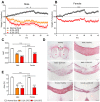Sex Differences in the Behavioural Aspects of the Cuprizone-Induced Demyelination Model in Mice
- PMID: 36552147
- PMCID: PMC9775311
- DOI: 10.3390/brainsci12121687
Sex Differences in the Behavioural Aspects of the Cuprizone-Induced Demyelination Model in Mice
Abstract
Multiple sclerosis is an autoimmune disease characterised by demyelination in the central nervous system. The cuprizone-induced demyelination model is often used in mice to test novel treatments for multiple sclerosis. However, despite significant demyelination, behavioural deficits may be subtle or have mixed results depending on the paradigm used. Furthermore, the sex differences within the model are not well understood. In the current study, we have sought to understand the behavioural deficits associated with the cuprizone-induced demyelination model in both male and female C57BL/6J mice. Using Black gold II stain, we found that cuprizone administration over 6 weeks caused significant demyelination in the corpus callosum that was consistent across both sexes. Cuprizone administration caused increased mechanical sensitivity when measured using an electronic von Frey aesthesiometer, with no sex differences observed. However, cuprizone administration decreased motor coordination, with more severe deficits seen in males in the horizontal bar and passive wire hang tests. In contrast, female mice showed more severe deficits in the motor skill sequence test. Cuprizone administration caused more anxiety-like behaviours in males compared to females in the elevated zero maze. Therefore, this study provides a better understanding of the sex differences involved in the behavioural aspects of cuprizone-induced demyelination, which could allow for a better translation of results from the laboratory to the clinic.
Keywords: anxiety; cuprizone; demyelination; motor coordination; multiple sclerosis; sex differences.
Conflict of interest statement
The authors declare no conflict of interest.
Figures






Similar articles
-
Behavioural changes observed in demyelination model shares similarities with white matter abnormalities in humans.Behav Brain Res. 2015;287:265-75. doi: 10.1016/j.bbr.2015.03.038. Epub 2015 Apr 2. Behav Brain Res. 2015. PMID: 25843560
-
Behavioural alterations and morphological changes are attenuated by the lack of TRPA1 receptors in the cuprizone-induced demyelination model in mice.J Neuroimmunol. 2018 Jul 15;320:1-10. doi: 10.1016/j.jneuroim.2018.03.020. Epub 2018 Apr 6. J Neuroimmunol. 2018. PMID: 29759134
-
Effects of commissural de- and remyelination on motor skill behaviour in the cuprizone mouse model of multiple sclerosis.Exp Neurol. 2006 Nov;202(1):217-24. doi: 10.1016/j.expneurol.2006.05.032. Epub 2006 Jul 20. Exp Neurol. 2006. PMID: 16857191
-
Pathological changes in mice with long term cuprizone administration.Neurochem Int. 2019 Jun;126:229-238. doi: 10.1016/j.neuint.2019.03.018. Epub 2019 Mar 30. Neurochem Int. 2019. PMID: 30940543
-
Behavioural phenotypes in the cuprizone model of central nervous system demyelination.Neurosci Biobehav Rev. 2019 Dec;107:23-46. doi: 10.1016/j.neubiorev.2019.08.008. Epub 2019 Aug 21. Neurosci Biobehav Rev. 2019. PMID: 31442519 Review.
Cited by
-
The Cuprizone Mouse Model: A Comparative Study of Cuprizone Formulations from Different Manufacturers.Int J Mol Sci. 2023 Jun 23;24(13):10564. doi: 10.3390/ijms241310564. Int J Mol Sci. 2023. PMID: 37445742 Free PMC article.
-
The effects of venlafaxine on depressive-like behaviors and gut microbiome in cuprizone-treated mice.Front Psychiatry. 2024 Jun 3;15:1347867. doi: 10.3389/fpsyt.2024.1347867. eCollection 2024. Front Psychiatry. 2024. PMID: 38899045 Free PMC article.
-
Quantitative Analysis of Early White Matter Damage in Cuprizone Mouse Model of Demyelination Using 7.0 T MRI Multiparametric Approach.ASN Neuro. 2024;16(1):2404366. doi: 10.1080/17590914.2024.2404366. Epub 2024 Oct 14. ASN Neuro. 2024. PMID: 39400556 Free PMC article.
-
Microglia-derived exosomes modulate myelin regeneration via miR-615-5p/MYRF axis.J Neuroinflammation. 2024 Jan 22;21(1):29. doi: 10.1186/s12974-024-03019-5. J Neuroinflammation. 2024. PMID: 38246987 Free PMC article.
-
Tlr7 drives sex differences in age- and Alzheimer's disease-related demyelination.Science. 2024 Nov 29;386(6725):eadk7844. doi: 10.1126/science.adk7844. Epub 2024 Nov 29. Science. 2024. PMID: 39607927 Free PMC article.
References
-
- Walton C., King R., Rechtman L., Kaye W., Leray E., Marrie R.A., Robertson N., La Rocca N., Uitdehaag B., van der Mei I., et al. Rising Prevalence of Multiple Sclerosis Worldwide: Insights from the Atlas of MS, third edition. Mult. Scler. 2020;26:1816–1821. doi: 10.1177/1352458520970841. - DOI - PMC - PubMed
Grants and funding
LinkOut - more resources
Full Text Sources

